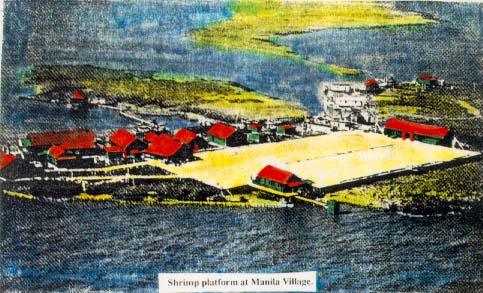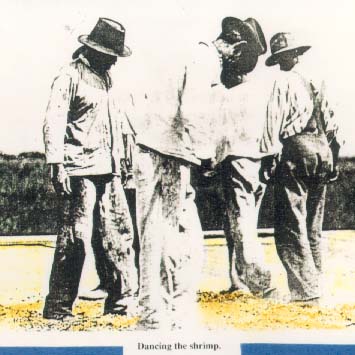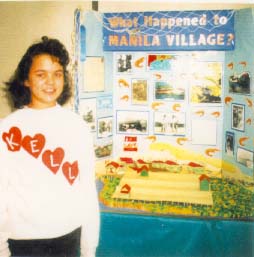
What Happened to Manila Village?
By Kelly Welch
Abstract- Before I can answer the question, "What happened to Manila Village?" I must first explain what Manila Village was.
The main product of this village, a settlement from before the turn of the century, was dried shrimp. It was an important resource to the economy then and also well into the 20th century. The shrimps were harvested in Barataria Bay (where Manila Village was located and sent to New Orleans for export to Asia, Canada, and South and Central American.
Most of my information was acquired from conversations with my grandmother, who spent her early life and many of her summers there. Also, a personal interview with Mrs. Marina Espina, the author of the book "Filipinos in Louisiana" was an invaluable resource for the project. I also gathered information from books, periodicals, and newspapers.
Report: Nestled in Barataria Bay, Manila Village was just a few miles southeast of Lafette, fifteen miles north of Grande Isle, and fifteen miles south of Myrtle Grove. Manila Village was home of Filipino seamen and fishermen for more than a century.
Manila Village was the largest, oldest, and most popular of the shrimping villages in the bay. The dozen or so red-roofed, green painted buildings, that made up the village were built on stilts at the edge of the bayou, constituting what was called "the platforms." The platforms built in a series of slopes with volleys between, to drain away excess water. They were the size of two football fields. Manila Village was named after the capital city of the Philippines. It was built on hand-driven pilings spread over fifty acres of marshland. The village had warehouses, a fuel dock, shelters for platforms workers, a general store, homes, and a post office called "Cabinash." Cabinash Island was across a small bay south west-like a suburb of the Villages.
Many trawlers contributed their daily catch to the platforms. Trawlers were "lugger" type boats that dragged a trawler along the sea or gulf bottom. All trawlers have to obtain a yearly license and display it at all times.
After the catch, everything except the shrimps were returned to the sea. The shrimps were then delivered
To the village for "washing" and boiling.
The sun-drying of shrimp, a method developed in the Philippines, was the chief occupation of most residents. This process required many stages. First, the shrimps were boiled for twenty minutes in copper caldrons containing coarse salt and water. Then, they were spread out to dry in a single layer on the huge platform. At regular intervals, they were "stirred with long, wooden rakes to ensure uniform drying. The process took three or four days in the summer, and five to ten days in the winter.
The shrimps
were raked to the top of the slopes and covered with tarpaulins at night
or during rainy weather.

Platform
workers trampled on the shrimps to remove the head and the hulls. This
unusual procedure was called "Dancing the Shrimp."
Louisiana water yielded half the shrimp consumed in the United States, and Manila Village ranked as one of the top producers of dried shrimp.
Conclusion: But, "What happened to Manila Village?" you may ask. Well, it was blown away in 1965 by a devastating hurricane called "Betsy."
Mrs Marina Espina went to look for Manila Village in 1976, but all that was left standing were pilings and one camp. Now there are only pilings left.
By doing
this project and researching the background of Manila Village, I have learned
that because of the destruction of this shrimping village, many Filipinos
had to turn to deep-sea shrimping, freezing shrimp or to other occupations.
Shrimp drying has become a commercial endeavor. Tidal waves and strong
winds may have swallowed the whole settlement, however, the waters could
not wash away the rich tradition of the early Filipino settlers. The descendants
of the people of Manila Village are proud of their heritage and their forefathers,
who made outstanding contributions to the history and economy of the State
of Louisiana. Kelly
Welch, New Orleans 1992
This is a Social Studies Project by Kelly Welch. She won First Place in her school and at the regional Social Studies Fair. Her grandmother, Isabel "Riggie" Gedoria Welch was the New Orleans Teacher of the Year in 1976. Her aunt become a school principal and also has a daughter, Cecilia Ann Dartez, who is a former teacher. Cecilia now writes books for children and series on the Internet. Ann's "Jenny Giraffe" series is on the internet and New Orleans Library. Another cousin taught for many years at Tulane University. Teaching seems to run in this family.
Riggie retired twice from teaching but continued to volunteer as Mother Goose, reading stories to kindergarten and first-grade classes at Dwight D Eisenhower School in Algiers, New Orleans.
Nestor Palugod Enriquez